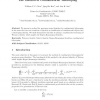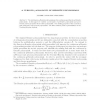46 search results - page 5 / 10 » jct 2011 |
JCT
2011
13 years 4 months ago
2011
We present a method for proving q-series identities by combinatorial telescoping in the sense that one can transform a bijection or classification of combinatorial objects into a ...
JCT
2011
13 years 4 months ago
2011
Two well-known q-Hermite polynomials are the continuous and discrete q-Hermite polynomials. In this paper we consider a new family of q-Hermite polynomials and prove several curiou...
JCT
2011
13 years 4 months ago
2011
We consider the problem of orienting the edges of the n-dimensional hypercube so only two different in-degrees a and b occur. We show that this can be done, for two specified in...
JCT
2011
13 years 4 months ago
2011
Abstract. We generalize a theorem of Knuth relating the oriented spanning trees of a directed graph G and its directed line graph LG. The sandpile group is an abelian group associa...
JCT
2011
13 years 4 months ago
2011
The neighborhood of a pair of vertices u, v in a triple system is the set of vertices w such that uvw is an edge. A triple system H is semi-bipartite if its vertex set contains a ...


